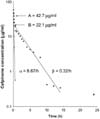1. Arai S, Kobayashi S, Hayashi S, Sakaguchi T. Distribution of cefpirome (HR 810) to exudate in the croton oil-induced rat granuloma pouch and its therapeutic effects on experimental infections in the pouch. Antimicrob Agents Chemother. 1988. 32:1396–1399.

2. Arret B, Johnson DP, Kirshbaum A. Outline of details for microbiological assays of antibiotics: second revision. J Pharm Sci. 1971. 60:1689–1694.

3. Bertram MA, Bruckner DA, Young LS. In vitro activity of HR 810, a new cephalosporin. Antimicrob Agents Chemother. 1984. 26:277–279.

4. Dardi MS, Sharma SK, Srivastava AK. Pharmacokinetics and dosage regimen of ceftriaxone in buffalo calves. Vet Res Commun. 2004. 28:331–338.

5. Gardner SY, Papich MG. Comparison of cefepime pharmacokinetics in neonatal foals and adult dogs. J Vet Pharmacol Ther. 2001. 24:187–192.

6. Gibaldi M, Perrier D. Pharmacokinetics. 1982. 2nd ed. New York: Marcel Dekker;433–444.
7. Hancock RE, Bellido F. Factors involved in the enhanced efficacy against gram-negative bacteria of fourth generation cephalosporins. J Antimicrob Chemother. 1992. 29:Suppl A. 1–6.

8. Isert D, Klesel N, Limbert M, Markus A, Seibert G, Schrinner E. Pharmacokinetics of cefpirome administered intravenously or intramuscularly to rats and dogs. J Antimicrob Chemother. 1992. 29:Suppl A. 31–37.

9. Jafari HS, Saez-Llorens X, Ramilo O, Shelton SL, McCracken GH Jr. Pharmacokinetics and antibacterial efficacy of cefpirome (HR 810) in experimental Escherichia coli and Haemophilus influenzae type b meningitis. Antimicrob Agents Chemother. 1991. 35:220–223.

10. Kavi J, Ashby JP, Wise R, Donovan IA. Intraperitoneal penetration of cefpirome. Eur J Clin Microbiol Infect Dis. 1989. 8:556–558.

11. Kita Y, Yamaaki T, Imada A. Comparative pharmacokinetics of SCE-2787 and related antibiotics in experimental animals. Antimicrob Agents Chemother. 1992. 36:2481–2486.

12. Klesel N, Seeger K. Pharmacokinetic properties of the new cephalosporin antibiotic HR 810 in animals. Infection. 1983. 11:318–321.

13. Mrestani Y, Bretschneider B, Hartl A, Neubert RHH. In-vitro and in-vivo studies of cefpirom using bile salts as absorption enhancers. J Pharm Pharmacol. 2003. 55:1601–1606.

14. Muller M, Rohde B, Kovar A, Georgopoulos A, Eichler HG, Derendorf H. Relationship between serum and free interstitial concentrations of cefodizime and cefpirome in muscle and subcutaneous adipose tissue of healthy volunteers measured by microdialysis. J Clin Pharmacol. 1997. 37:1108–1113.

15. Nakanomyo H, Esumi Y, Takaichi M, Seki H, Ninomiya S, Okamura Y, Sudo Y. Study on the pharmacokinetics of cefepime (II). Jap J Antibiot. 1992. 45:938–942.
16. Paradis D, Vallee F, Allard S, Bisson C, Daviau N, Drapeau C, Auger F, LeBel M. Comparative study of pharmacokinetics and serum bactericidal activities of cefpirome, ceftazidime, ceftriaxone, imipenem and ciprofloxacin. Antimicrob Agents Chemother. 1992. 36:2085–2092.

17. Rule R, Quiroga GH, Rubio M, Buschiazzo HO, Buschiazzo PM. The pharmacokinetics of ceftazidime in lactating and non-lactating cows. Vet Res Commun. 1996. 20:543–550.

18. Sauermann R, Delle-Karth G, Marsik C, Steiner I, Zeitlinger M, Mayer-Helm BX, Georgopoulos A, Muller M, Joukhadar C. Pharmacokinetics and pharmacodynamics of cefpirome in subcutaneous adipose tissue of septic patients. Antimicrob Agents Chemother. 2005. 49:650–655.

19. Sharma SK, Srivastava AK. Cefotaxime pharmacokinetics in male buffalo calves following multiple dosing. Vet Arh. 2003. 73:191–197.
20. Wisemann LR, Lamb HM. Cefpirome. A review of its antibacterial activity, pharmacokinetic properties and clinical efficacy in the treatment of severe nosocomial infections and febrile neutropenia. Drugs. 1997. 54:117–140.






 PDF
PDF ePub
ePub Citation
Citation Print
Print







 XML Download
XML Download